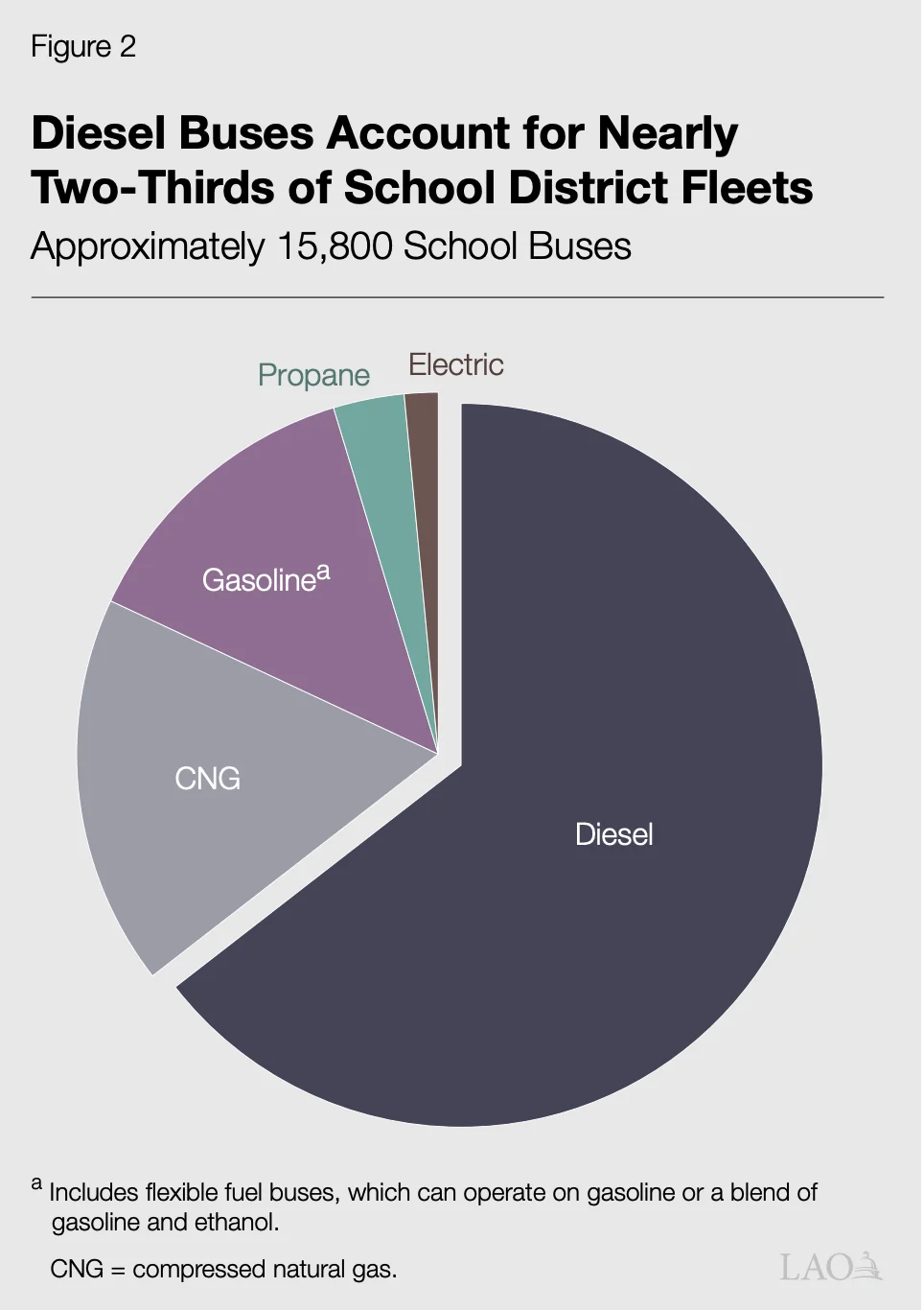Safety, Efficiency, Sustainability
How California schools can use historic education funding to improve school bus access & safety
October 17, 2022

Get the latest from Samsara
Subscribe nowToday is the first day of National School Bus Safety Week, an annual awareness event that highlights the importance of safe student transportation across the United States.
This week is particularly important for school transportation administrators in California—a state that has long experienced challenges around school transportation. California is the least funded state for school transportation in the U.S. based on per capita student enrollment, with a ridership of just 9%. Furthermore, though students are 70 times more likely to arrive at school safely by school bus than by car, there were still more than 1,200 fatalities across the country due to school bus accidents between 2009 and 2018.

Figure from February 2022 California Legislative Analyst's Office (LAO) report.
Historic new funding may help address these access and safety challenges in California. In June 2022, Governor Gavin Newsom passed a record-breaking $308 billion state budget. Among the many civic needs this money will address, $170 billion is dedicated to addressing problems occurring in the California public school system, including declining enrollment, teacher shortages, achievement gaps—and school transportation.
In this guide, we’ll walk through what California school transportation administrators need to know about two new programs: the Home to School Transportation Program and the Green School Bus Grant, both created by the state budget and funded by Proposition 98. Keep reading to learn how you can use this new funding to address your school district’s most pressing school transportation access and safety challenges.
What is the Home to School Transportation program?
Passed in 1998, Proposition 98 guarantees a minimum level of funding for California’s K-12 public schools and community colleges (collectively referred to as K-14 schools). Since its inception, Proposition 98 funding levels have steadily increased, from an estimated $96.1 billion in 2020 to $110.2 billion in 2021 and $110.4 billion in 2022.
The state’s final budget provides a historic $637 million of ongoing Proposition 98 general fund money to the new Home to School Transportation program, a local control funding formula add-on. This allows local education agencies (LEAs) to receive a 60% reimbursement of their transportation costs, or their current add-on, plus ongoing cost of living adjustments (COLA). Reimbursable transportation costs may include fuel costs, new school buses, new technology deployed in school buses, and other costs related to school transportation.
To apply for the reimbursement, LEAs must develop a comprehensive plan that describes how they will provide transportation services to their students, prioritizing low-income students and those in transitional kindergarten through sixth grade. Here’s what you need to know about developing a comprehensive plan to qualify for Home to School Transportation reimbursement:
The plan must include a description of how the LEA’s transportation services would be used to benefit students with disabilities and low-income students.
The plan must also include a description of how the LEA’s transportation services would be used to benefit students that are English learners, students that are eligible for a free or reduced-price meal, or students who are foster youth at no cost.
Besides those within the LEA, the plan must be created through collaboration with stakeholders such as staff, teachers, school administrators, local transit authorities, local air pollution districts, parents, and others.
Once the plan is created, it must be presented and adopted by the LEA’s governing board and be made available for discussion among the general public.
The LEA’s governing board must implement the plan by April 1, 2023 to be qualified for reimbursement through the new Home to School Transportation program.
What is the Green School Bus Grant?
California owns approximately 15,800 school buses, with nearly two-thirds of school buses running on diesel. Diesel school buses are costly, both financially and environmentally. California school districts spend $1.8 billion on home to school transportation, with fuel expenditure accounting for 10-20% of that budget. On top of that, diesel emissions pose a dangerous risk to human health and the state’s carbon footprint.

Figure from February 2022 California Legislative Analyst's Office (LAO) report.
To help address these challenges, the state budget provides $1.5 billion in one-time Proposition 98 funds to the California Energy Commission (CEC) and California Air Resources Board (CARB) to administer a zero-emission school bus program, dubbed the Green School Bus Grant, that will replace existing school buses with electric school buses. Early estimates predict that this funding will allow school districts to replace as many as 3,000 school buses.
Applicants for the Green School Bus Grant are expected to receive priority if they:
Have a high population of low-income students and English learners.
Propose replacing the oldest buses.
Propose purchasing electric school buses with bi-directional charging.
Have 2,500 or fewer students.
Are located in rural areas.
Grants are expected to start at $500,000 for the replacement of one bus (electric school buses cost around $400,000). Recipients must scrap their old buses within a year of receiving their new buses. In addition, recipients must use at least 90% of their grant for purchasing the electric bus and related infrastructure (such as charging stations). The remaining 10% can be spent on any other school transportation-related cost, including more school buses, hiring, training, administrative costs, innovative safety technology, and more. The CEC and CARB are currently developing the application procedures.
Improve school transportation operations & safety with Samsara
School bus safety poses a massive risk to student transportation. Across a 180-day school year, motorists commit more than 17 million stop-arm violations; that means there are equally as many opportunities for a school bus collision or blind spot-related accident to occur.
In California, where both funding and ridership are among the lowest in the nation, this historic new funding will make it possible for California schools to reinvest in their school transportation programs—increasing access, sustainability, and safety for millions of students who need to get from home to school every day.
Samsara can be your partner in modernizing your school transportation program and improving school bus safety. Samsara offers a comprehensive platform that empowers school districts to streamline camera systems, minimize on-the-road accidents, and improve student safety. With functionality that includes auto-uploaded incident footage, automated coaching workflows, advanced telematics, preventative maintenance alerts, and real-time GPS, you can transform your school transportation operations.
Samsara can help schools:
Instantly account for students & ensure both driver and student safety: Improve driver and student safety with AI Dash Cams or 360° video from third-party cameras. Take immediate action with real-time alerts and instant footage. Monitor stop paddles and bus conditions remotely, and ensure no student is left behind with workflows to check for sleeping children after a route. Log bus activity with NFC ID readers and ridership reports. Reduce inbound calls with real-time bus locations and ETAs through parent app integrations.
Respond to and resolve incidents faster: Quickly respond to complaints by verifying where your buses and vehicles were. Protect the reputation of the district and relationship with the community. No retrieval requests, SD cards, or manual footage review—HD video is instantly uploaded for centralized management, alerts, and controlled access.
Leverage data to improve operational efficiency: Identify buses in need of service with live engine diagnostics and fault alerts, and use preventative maintenance schedules to avoid breakdowns. Import or integrate routes from popular planning tools to compile rosters, balance bus loads, and monitor on-time performance with precise GPS. Automate everything from logging a morning school bus inspection to ensuring sanitization.
Streamline your transition to electric school buses: Leverage data and advanced reporting to understand which diesel-based school buses are the best candidates to be replaced with electric school buses. Seamlessly transition to managing a mixed fleet with visibility into real-time electric bus data, including charging status and battery health.
See how Samsara is already empowering schools across the country, or get in touch with our team to learn more about how you can create smarter, safer, and more efficient school transportation operations with Samsara.
Learn more about Samsara for school transportationGet the latest from Samsara
Subscribe now

















